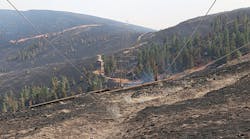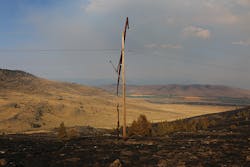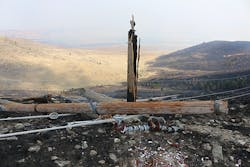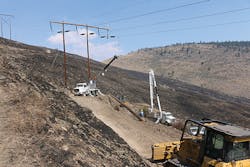The smoke had barely cleared from the blackened field of cheat grass and the newly erected poles when the questions started coming in: Was anyone hurt? What utilities were impacted by the damaged transmission poles? Was power lost? If so, was it restored? Do you have the supplies you need? And then the big one: What other Bonneville Power Administration assets are threatened by wildfires?
While BPA had the answers, they were piecemeal — part of the information was owned in one control center and the other part resided in another. Not everyone knew the right people to ask, so the farther away they got from the scene of the work, the less clear things became.
Also, at that point in time, BPA had no idea what the next two weeks would bring. Specifically, the Pacific Northwest suffered through a long, dry summer with record-setting periods of high heat. Counties in both Washington and Oregon were declared to be in states of drought emergency. Much of the eastern side of the Cascade Mountains lay like a giant tinderbox waiting for an errant spark or flash of lighting. Across the region, fires were breaking out.
Several utilities in the region had lost portions of lines or even access to generation as a result of the fires. BPA tracked these fires closely as many of these utilities were customers. When possible, the agency provided assistance like helping to lay out poles. The agency also stood ready to answer greater calls for assistance, should they come.
Responding to the Fires
BPA, which operates three-quarters of the region’s transmission grid, delivers power through more than 15,000 circuit miles of high-voltage line through 259 substations. By August, its high-voltage transmission lines had been largely unaffected by the wildfires. Most of the towers are steel, and the conductor was suspended high enough to be out of direct harm’s way.
Not every transmission corridor in the system, however, has the advantage of being built out of steel. The lower the rating of the line, the more likely it may be strung along wood poles. From a statistical perspective, it was only a matter of time before BPA felt the flames.
On August 14, a grass fire burned under Hot Springs–Rattlesnake 230-kV line in northwestern Montana. Several poles along the line were damaged, knocking out service to BPA customer Mission Valley Power. While BPA’s Kalispell line crew and substation operators would restore power within an hour, the damaged poles would take four days to replace. In less than 12 hours, two other high-voltage lines were damaged by wildfires in eastern Washington.
Improving Communication
The following week, executives grappled with several big questions: What other assets might be threatened by wildfires? How could the agency best position itself to keep people safe from harm and provide assistance as needed to other utilities throughout the region?
But as they recounted what they knew about the location of the fires and the proximity to the lines, as well as the needs of the customers, it became clear that there wasn’t a common perspective and there were still questions that needed to be answered. All it takes is one or two details in the basic storyline to change, and soon, there’s enough variation for managers and executives to question whether they have a clear view of what’s going on.
There’s no question that BPA’s Transmission Services takes care of its work. This group keeps the lights on, repairs damage, replaces assets and restrings new conductor after it fails. Over nearly eight decades, BPA has a long legacy of wading headfirst into wind storms, snowstorms and thunderstorms to restore lost power. At the same time, however, BPA realized there was one area where it could be stronger — communication, both across its organization and outside of BPA with other utilities, and city, state and federal agencies.
BPA learned that lesson back in 2012 with Hurricane Sandy. When that confluence of storms socked the East Coast, BPA responded with personnel and equipment. But when the crews arrived, precious hours were lost as they looked for the best way to plug in. The agency didn’t understand the structure of the Incident Command System (ICS). In other words, they didn’t speak their language, and they hadn’t followed a normal process for integrating into a federal emergency.
While BPA’s line crews ended up doing outstanding work restoring power in some of the hardest-hit areas of New Jersey, BPA learned its lesson. It needed to not only understand but also to embrace ICS and the National Incident Management System if it wanted to be part of any emergency response effort that reached beyond its transmission system.
In many large-scale disaster situations, the restoration of power is a fundamental step toward recovery. So while some personnel had dabbled in a few FEMA classes and were even certified to respond to incidents, the organization as a whole still had to find a way to educate its leadership and workforce on the benefits of ICS.
Reaping the Benefits of ICS
ICS provides a mechanism to integrate different functions at BPA — supply, engineering and finance — into a singular team that more efficiently responds to an unfolding situation. It also enables a much more simplified means for external agencies or other utilities to interact with BPA and vice-versa.
Another benefit of ICS is the separation it provides between BPA continuity of operations and the incident response itself. By having an ICS response that operates with a flexible but limited number of employees, the remainder of BPA can focus on the day-to-day operations and critical mission of delivering power at a low cost to the region.
That same separation also provides the people on the front lines of emergency response some cover from distractions such as media inquiries or executives looking for the latest update. Instead, the media and the leadership can contact the ICS staff to get what they need.
ICS provides the one thing BPA executives and managers needed most during the dynamic period in late summer 2015 — a common operating picture. One point of contact provides a unified and comprehensive picture of the activities underway.
On August 25, BPA activated an Incident Management Team (IMT) whose purpose was to keep people and equipment safe, to provide coordinated monitoring of the continuing wildfire season, and to ensure efficient and effective response to customers’ needs.
Among the first actions taken by the IMT was to pull in resources from BPA’s Geospatial Services Group. The IMT requested maps that covered the broad service territory. In turn, the Geospatial Services Group provided the IMT with a real-time geographic information system (GIS) map showing the extent of active wildfires from the Geospatial Multi-Agency Coordination project along with BPA’s transmission lines, the service territories of utilities and tribal boundaries. Better yet, the map resided on an external web page (www.bpagis.maps.arcgis.com) that allows the customers, public and media to access the information on any smart-enabled device or PC with Internet access.
Preventing Fire Damage
The GIS map helped BPA to prevent possible fire damage to the assets. For example, one of the line maintenance crews spotted a swath of more than 80 burnt trees in steep terrain just outside the BPA right-of-way on the Colville–Republic No. 1 115-kV line in northeastern Washington. The crew removed a tree identified as an imminent threat, and the IMT worked to develop a way to remove the trees without needing to de-energize the line.
On the evening of August 27, a fast-moving wildfire burned through BPA’s Shelton–Fairmount transmission lines about 9 miles north of the town of Shelton at the base of the Olympic Peninsula in Washington. The fire resulted in a loss of load to the customers at Mason County and Jefferson County PUDs on two 115-kV lines. BPA line crews from Olympia and Chehalis worked in the difficult terrain to restore power in just a couple of hours.
Two days later, one of BPA’s dispatch centers received a “primary station service failure” alarm at its Tucannon River substation in Columbia County, Oregon. A Columbia Rural Electric Association transmission line had taken a lightning strike, resulting in a conductor on the ground and a fire. The fire burned under the BPA’s Tucannon River–North Lewiston No. 1 115-kV line, but the crews reported no damage to either the wood poles or to the hardware. BPA helped Columbia REA remove jumpers to isolate REA’s damaged line and managed to restore service to the substation in less than six hours.
In addition, two more wood pole transmission lines would be knocked out of service by a fire on August 30 in Richland and Spokane, Washington. In both cases, BPA would restore customer load by early evening.
For the most part, the IMT remained in an advisory role, providing a common operating picture throughout the agency that helped inform operational decisions. It also gave the line crews and operators some relief from media. While the media has a clear and critical need to inform the public, their work can be distracting or consume the time of the workers in the field who are actively responding to an emergency.
The IMT further provided its members with the opportunity to function in roles they had trained for even as it served as a quickly scalable group who could expand roles and responsibilities as BPA needed.
BPA was fortunate that the wildfire activity was abated without further impact to the agency. A little more than a week after it was mobilized, the IMT disbanded, having successfully completed its mission. Now BPA is a little wiser and more prepared for the next time it is needed.
Ultimately, that is why BPA is embracing ICS. All of BPA’s 3,100 employees — whether they are a member of the line crew, an operator or work in another position — live in the communities they serve. When disaster calls, BPA will be able to answer the questions that arise in the immediate aftermath. More importantly, BPA will be ready to help its communities take the first step to recovery by restoring power and getting the lights back on.
Doug Hunter is the internal operations manager for transmission field services at Bonneville Power Administration and served as the commander of the Incident Command System team. Hunter has been with BPA for 13 years. In this current role, he is responsible for the vegetation program, technical training, work planning and evaluation, and asset data management.





